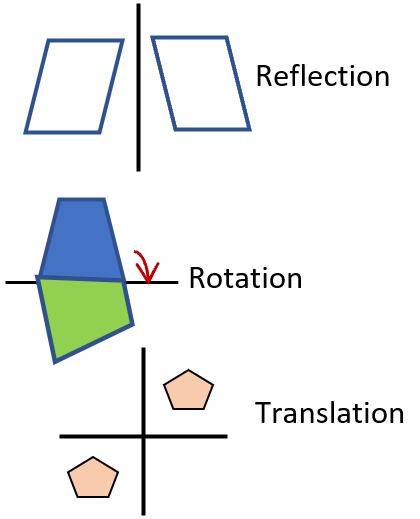In the realm of geometry, transformations such as translations, rotations, reflections, and dilations serve foundational roles in understanding shapes and their properties. Among these, the relationship between translations and reflections offers a compelling narrative, particularly when analyzed through the lens of cultural relativism. This examination asserts that any translation can indeed be elucidated as the result of two reflections, drawing parallels not simply in mathematical practice but also in broader cultural interpretations and manifestations of geometric principles.
The concept of translation in geometry implies shifting a figure in a specific direction without altering its orientation or size. In more rigorous terms, a translation involves moving every point of a geometric object the same distance in a specified direction. This process is elegantly formulated in vector notation, which allows for concise representation and calculation. Conversely, reflections involve flipping a figure across a line (the line of reflection), thereby altering its orientation while theoretically preserving its shape and dimensions.
At first glance, it may appear paradoxical to assert that a simple translation can be expressed through the mechanics of reflection. However, delving deeper reveals that this dualistic relationship symbolizes more than mere mathematical equivalence. When reflecting upon transformations, it is crucial to consider the cultural significances that different societies ascribe to reflection and translation, as these concepts resonate variably across cultural contexts.
The mathematical assertion that any translation can be articulated as a composition of two reflections is formally established in geometric algebra. Specifically, if one reflects a point across one line, then a reflection across a second line that is parallel to the first will yield a translation in the direction perpendicular to the line of reflections. This relationship is encapsulated in numerous geometric theories and proofs, emphasizing the intrinsic connections between these transformations. Thus, any translation vector can be quantitatively represented as the sum of two reflections across strategically chosen axes.
Transformations in geometry are characterized by their invariant properties—qualities maintained through manipulative processes. In a cultural context, invariant properties can metaphorically parallel societal norms and values. For instance, translation, often associated with progress and movement, is valorized in many cultures that prize innovation and forward thinking. Meanwhile, reflections poignantly symbolize introspection and self-evaluation. Each cultural framework approaches these ideas differently, underscoring their significance beyond mere shapes and figures.
To elucidate this relationship, one may utilize cultural narratives that reflect societal values regarding transformation and duality. In numerous indigenous cultures, for instance, the concepts of reflection and translation might manifest through storytelling. Legends often encompass a journey (translation) toward self-discovery, reflecting through struggles and triumphs (reflections). Thus, geometrical concepts find resonance in the fabric of human experience, with cultural relativity highlighting the varied interpretations thereof.
Mathematics itself is a language crossed with cultural discourse. The duality of transformation—represented by translations and reflections—mirrors the dualities apparent in human relationships, conflicts, and reconciliations within societies. Just as a shape can be translated through reflections, so too can ideas, beliefs, and norms be transformed through societal dialogue and exchanges, transcending rigid structures and fostering dynamic interactions. This conceptual harmony underscores the relevance of geometry as a metaphor for cultural exchange and evolution.
Moreover, the implications of viewing translations through the lens of dual reflections extend to fields such as art and design, where spatial transformations can signify deeper meanings and themes. In the realm of visual arts, artists often engage with reflection and translation not just as techniques of manipulation but as statements of identity, heritage, and the transformative experiences of culture itself. A juxtaposition of mirrored images can provoke contemplations on self-representation and duality in cultural identity, akin to reflections in geometry.
Thus, the interplay between translations and reflections in geometry serves as a powerful metaphor for broader cultural dynamics. Academic discourse surrounding this relationship invites interdisciplinary conversations bridging mathematics, philosophy, and cultural studies. Such dialogues enrich our understanding of how fundamental mathematical concepts can be interpreted and reinterpreted within diverse cultural milieus, compelling us to reconsider the universality of geometric principles.
Ultimately, the assertion that any translation can be achieved through two reflections encapsulates profound philosophical implications. It invites a dialogue about the nature of transformation itself—be it mathematical, cultural, or personal. This merging of geometry and cultural relativism fosters a richer appreciation for the educational journey, demonstrating that abstract mathematical theories can resonate with the fabric of daily life and human experience.
In conclusion, the exploration of whether any translation can be replaced by two reflections not only unravels complex geometric principles but also bridges cultural narratives and principles. This intersection serves to remind us of the universality of transformation, advocating for an understanding that transcends disciplinary boundaries and embraces the diversity of human thought and expression. The implications for education, culture, and personal growth remain profound, urging further inquiry into the reciprocal relationships between mathematics and cultural identity.
